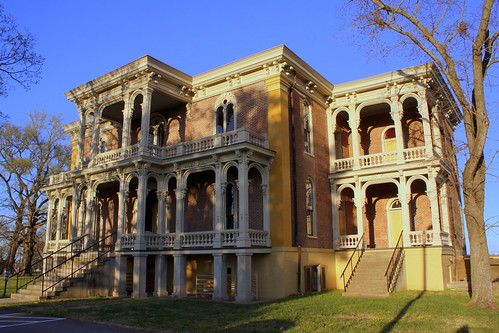
From Wikipedia:
Clover Bottom Mansion occupies land on the Stones River first claimed in 1780 by John Donelson, who abandoned his homestead following an Indian attack. The mansion was built in 1858 and was the centerpiece of the 1500 acre Clover Bottom Plantation.
The Mansion was built near Nashville's first horse-racing track for Dr James and Mary Ann Saunders Hoggatt, who owned sixty slaves. Mrs. Hoggatt was a granddaughter of Daniel Smith, and her half-brothers were Andrew Jackson Donelson and Daniel Smith Donelson, for whom Ft. Donelson was named. The mansion was constructed in the Italianate style. A strong similarity to nearby Two Rivers Mansion that was being erected around the same time suggests that the same unknown contractor and/or architect was used, although no records have been found. The interior of the home had French scenic Zuber wallpaper, and the parlor had a frescoed ceiling. Clover Bottom Plantation was the childhood home of John McCline, whose autobiography "Slavery in the Clover Bottoms" provides a rare and detailed account of the life of a Davidson County slave prior to and during the early days of the Civil War. A Tennessee Civil War Trails marker was erected on the property in 2015 detailing the story of McCline. Dr. Hoggatt died in 1863, and the home was occupied at different times during the Civil War by soldiers from both armies. Mrs. Hoggatt's brother-in-law, the former U.S. and Confederate Congressman Meredith P. Gentry, was left destitute from investing his money in the Confederacy and moved into the home. He died at Clover Bottom in 1866.
In the 1886 the property was sold to Andrew Price. Mr. Price, married to Anna Gay Price, was a four term Congressman from Louisiana who had Tennessee roots. Price restored the home and added several substantial outbuildings, raising thoroughbred horses on the property.
In 1918, A.F. Stanford purchased the house, and his widow Merle Hutcheson Stanford Davis (1907-2011) owned it until she sold it to the state in 1948. The house was converted into housing for faculty for the Tennessee School for the Blind. It then suffered an unfortunate period of neglect and abandonment starting in the early 1980s, until an effort led by Edward Nave and fellow members of the local Association for the Preservation of Tennessee Antiquities helped convince the state to restore it. It has been the home of the Tennessee Historical Commission, the State Historic Preservation Office, since it was renovated in 1994. The property contains several important historic outbuildings, including two former c. 1858 slave cabins that are among a handful of former slave dwellings remaining in Davidson County. There is also a c. 1850s carriage house that may slightly predate the present dwelling. The c. 1890s transverse crib thoroughbred horse barn is one of the finest 19th-century barns remaining in the area. At the initiative of the Tennessee Historical Commission, the historic outbuildings were restored by the State in 2015-16 and interpretive signs were added. Over 150 trees of native species were planted, and a walking trail is being added. The grounds are open to the public during daylight hours. Tours of the house (which has no period furnishings or exhibits) are by appointment only.
It was listed on the National Register of Historic Places on April 3, 1975.
No comments:
Post a Comment